This was published 8 years ago
Endangered animals: 20 wildlife encounters to put on your bucket list
By Julie Miller

Tourists watching Pandas being fed. Credit: Alamy
A fascination with our fellow inhabitants of the planet seems to be imprinted on human DNA. For a child, wild animals are a thing of wonder, and as we grow older, to see them in the flesh is a rite of passage.
While the rich and powerful have collected wild animals for centuries, the notion of the modern zoo dates back to the 18th century, when exotic species discovered during European exploration were contained in jails of steel and concrete for the entertainment of a very receptive public.
Times have fortunately changed for the animal kingdom, and as the notion of animals in captivity becomes more abhorrent, so the wonders of travel provide opportunity to experience them in their natural habitat.
There is simply no comparison to observing creatures in the wild; watching them going about their business, on the hunt or grazing, at one with their environment. But even low-impact tourism can take its toll on wildlife – so where do we draw the line at our interaction?
"If it's not managed properly, tourism can have negative impacts on animal populations and fragile habitats," says Dermot O'Gorman, from WWF. "Massive influxes of tourists, often to a relatively small area, can add to the pollution, waste, and water needs of the local population, putting local infrastructure and habitats under enormous pressure."
Furthermore, our very presence in a wildlife habitat can impact on animal behaviour, from changing feeding habits to placing them in danger from vehicles.
"Life is such an energy balance; one wrong move from us could have uncountable unforeseen repercussions," says Anantara Resorts' director of conservation, John Roberts.
"If we're going to show the wonders of the natural world to people – which I believe we have to, both to instil a need to protect and to help pay for their protection – there have to be compromises. But as long as we don't cause behavioural change, I think we're on the right track."
For many animal lovers, a visit to a wildlife sanctuary provides the rare opportunity to interact with species on a more intimate level, becoming directly involved in the care and management of animals rescued from poachers or the wildlife trade.
A recent report by World Animal Protection, however, has placed the spotlight on all animal attractions, suggesting that any hands-on encounter is essentially cruel, and calling on an end to "irresponsible wildlife tourism".
See: How your holiday may contribute to animal cruelty
This condemnation follows other responsible tourism companies, such as World Expeditions, banning elephant rides and animal shows from their itineraries, encouraging travellers to instead seek ethical alternatives to wildlife viewing.
"World Expeditions has developed its own animal welfare in tourism code of conduct in partnership with World Animal Protection," says World Expeditions chief executive Sue Badyari. "On the few occasions where we include visits to animal sanctuaries or shelters, we have reviewed these facilities to ensure they have the animals' welfare as first priority, and operate for the purpose of rehabilitation and where possible release."
Anantara's John Roberts agrees that the term "sanctuary" can be a misnomer.
"A true wildlife sanctuary ought to be totally hands off – there ought to be no guaranteed sightings, no enclosed areas and no breeding unless for controlled, scientific release. Everything else is just degrees of captivity and the term sanctuary misused," he says.
See also: The world's best national parks
In the case where wild release is not on the agenda, however, Roberts believes there is a place for human/animal interaction, with the rewards going both ways.
"The behind the scenes tour at Cambodia's Phnom Tamao Wildlife Rescue Centre is one of the perfect examples I've recently encountered," he says. "We got hands-on with several animals that for various reasons could never be released but, in doing so, were inspired and learned about the animals they will release.
"We actually have a similar distinction at our turtle shelter in Phuket. We work with the government to both release turtles and protect their habitat, but the only turtles you can meet (and sometimes touch) are blind or missing flippers and so can never survive in the wild.
"They inspire everyone to go away wanting to protect the sea and swearing never to use plastic bags again!"
So pack your binoculars, tread lightly, and above all, be respectful as you enjoy the rewards of observing these amazing Top 20 animals, as selected by our panel of wildlife experts.
GREY WOLF
See also: National parks - American's best ever idea
Where: Yellowstone National Park or Grand Teton National Park, Wyoming
Why we love them: The reintroduction of the grey wolf into the ecosystem of America's west is one of the great conservation success stories – and also the most controversial, with the return of the apex predator shifting the ecological balance. A team of dedicated wolf-watchers monitor the wolf pack's every movement, with tourists welcome to observe from a safe distance.
Expert says: You only want to do this with a professional guide, who knows the area and knows how to view wolves. You need to understand that you won't get to see a wolf up close and personal, so make sure you have some type of lens, like good binoculars to view them. Dermot O'Gorman
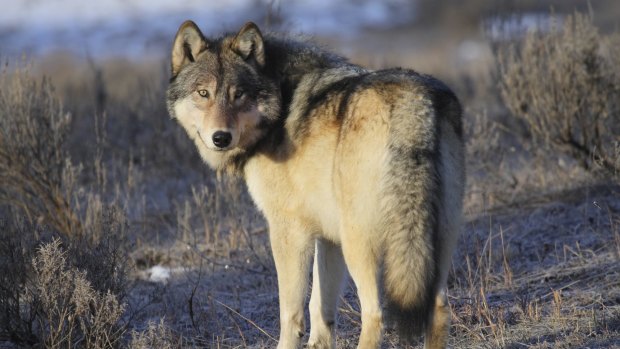
Grey wolf, Yellowstone National Park, USA.
KING PENGUIN
See also: Where simple life meets stunning luxury
Where: Antarctica; Tierra del Fuego, Argentina
Why we love them: Dignified, handsome and just a little comical, these Happy Feet favourites are the best excuse ever to visit Antarctica. The second-largest penguin, it lives in dense colonies with hundreds of thousands of birds packed onto barren beaches and valleys away from snow and ice. King Penguins carry their eggs on their feet, being shuffled from one parent to the other during the 55-day incubation period.
Expert says: With its huge glaciers, spectacular peaks and profusion of wildlife, Antarctica's South Georgia Island is one of the most beautiful places in the world. It's here where I experienced the thrill of walking among thousands of majestic King Penguins - just sublime. Sue Badyari
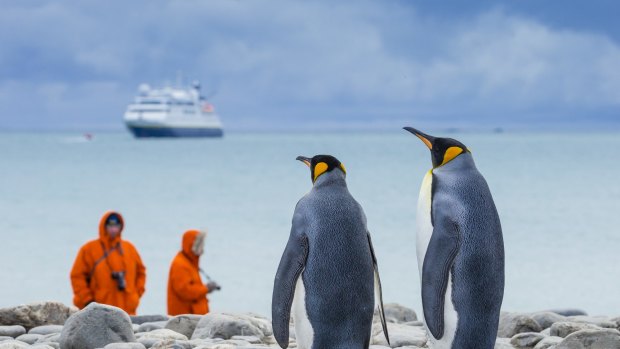
King Penguins in the Salisbury Plains, South Georgia, Antarctica. Credit: Ralph Lee Hopkins/National Geographic/Getty Images
AFRICAN ELEPHANT
See also: Everything you need to know about going on safari
Where: Botswana; Serengeti National Park, Tanzania; Kruger National Park, South Africa
Why we love it: The sheer scale of these magnificent creatures is enough to take your breath away; linger in their presence and you'll start to appreciate their social complexities and tight-knit family bonds. Although numbers are healthy in protected areas of southern Africa, overall numbers are in sharp decline as poaching continues to take its toll.
Expert says: Stay with them; watch and be patient, focusing on the subtleties of their behaviour. Sven Lindblad.
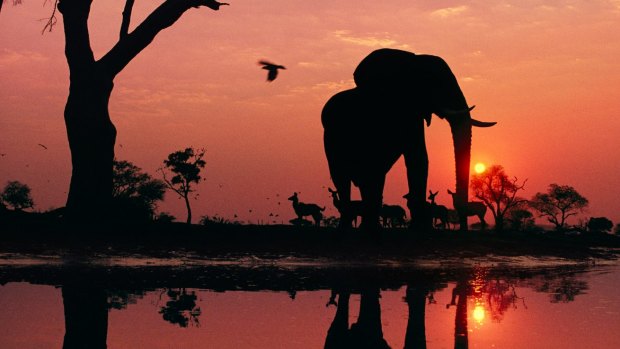
Credit: Getty Images
PUFFIN
See also: The isolated country where tourism is booming
Where: Scottish islands, Iceland
Why we love them: With their colourful beaks, striking colours, rolling walks and tragic-comic expression, puffins are an amazing sight on rugged cliffs in the extreme northern hemisphere.
Expert says: When visiting colonies, stay on the marked tracks – they are there for a reason and you don't want to disturb a nesting site. Belinda Fairbrother
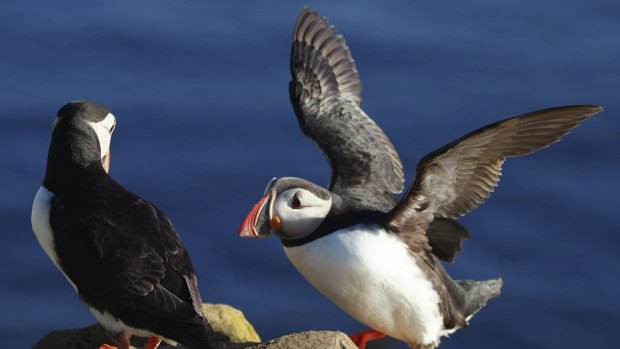
Puffins, Iceland.
BENGAL TIGER
See also: Watching tigers in the jungle
Where: Chitwan National Park, Nepal; India
Why we love it: As elusive as it is magnificent, the largest of all Asian cats hypnotises with its sheer beauty and supreme confidence, a reward for those patient enough to seek its presence in the wild. The latest survey of India's critically endangered tiger population suggests that numbers have recovered slightly to around 2200 individuals.
Expert says: Try not to want to see a tiger, they will only be seen when they want to; so relax and enjoy the rest of nature around you. I recommend Chitwan National Park as it is prime habitat with great numbers, but has few visitors so the tigers aren't habituated. John Roberts
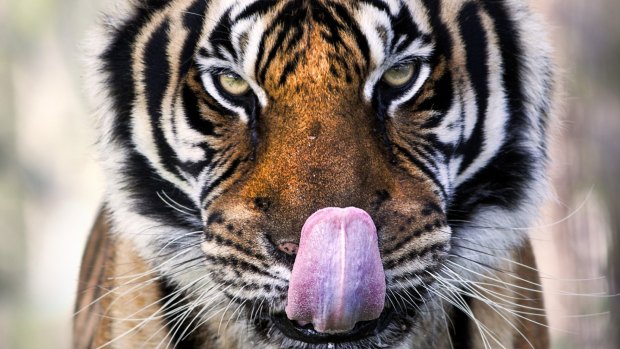
Credit: Stocksy
GIANT PANDA
Where: Chengdu, China
Why we love it: One of the rarest animals in the world, incredibly shy and notoriously difficult to see in the wild, the Giant Panda is more likely to be seen at a zoo, in itself a memorable experience. Adorably cute, these bamboo-chomping vegetarians are largely solitary, with the female only fertile for a few days once a year.
Expert says: As the emblem for WWF around the world, seeing a panda in the wild is almost impossible; when we stumbled across a young adult panda in China's Qin Ling Mountains, I couldn't believe we'd seen one. The panda got a surprise and ran off very fast when he heard the camera shutter – these things can actually move very fast. Dermot O'Gorman
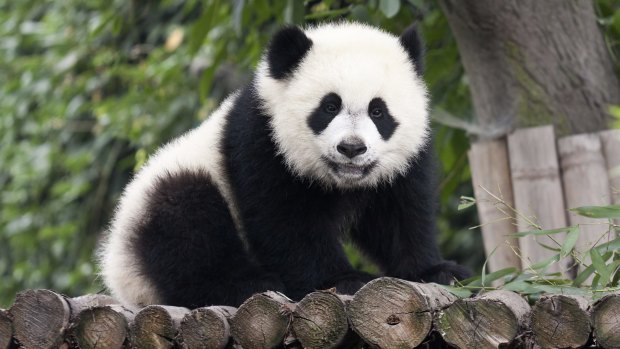
Young panda bear, China.
MOUNTAIN GORILLA
Where: Rwanda, Uganda
Why we love it: Observing these magnificent, critically endangered creatures in their high-altitude mountain forest homes requires effort and patience, a privilege that will leave an indelible impression. Up close, they are intimidating yet absolutely enthralling, truly a reflection of our own humanity.
Expert says: Sitting quietly at the feet of an enormous silverback gorilla with its piercing yellow eyes in the Virunga Mountains of Rwanda was humbling, exciting and frightening all at once. It was a completely unforgettable experience. Sue Badyari
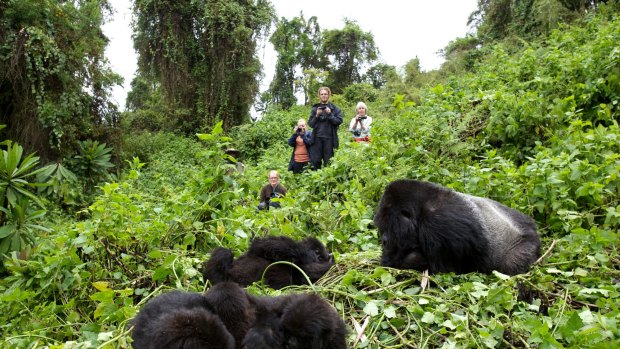
Tourists watching mountain gorillas, Rwanda.Credit: Getty Images
GRIZZLY BEAR
Where: Alaska, Canada, Yellowstone National Park, USA
Why we love it: Despite their cuddly appearance, grizzly bears are strong, stealthy and indiscriminate predators, an enduring symbol of the wild that brings the US National Park system to life. As they often wander near roads in search of food, viewing them is simple though demanding of respect and a sound mind.
Expert says: It can often be a matter of luck if you come across a Grizzly Bear. If you do – show respect. Use binoculars to allow you to view bears without getting too close. Belinda Fairbrother
BLUE WHALE
Where: West Coast North America; Sea of Cortez, Mexico; Victoria and NSW coastlines during winter.
Why we love them: As the largest animal ever to inhabit the Earth, viewing these marine mammals in the wild is a powerful experience. An adult blue whale consumes around 3.6 tonnes of krill a day; their tongues alone can weigh as much as an elephant.
Expert says: It's imperative to go with people who understand the behaviour and movements of these immense whales. Sven Lindblad.
ASIAN ELEPHANT
Where: Thailand, India, Sri Lanka
Why we love them: We are only just quantifying elephants' intelligence but their loyalty and family bonds have been studied anecdotally in Asia for centuries. One thing is for sure, watching a family going about their business in the wild is an unforgettable, heartwarming experience.
Expert says: Kui Buri National Park, Thailand, is a great place for observing herds – relatively open habitat means they can be watched exhibiting natural behaviour. They are not habituated so have not resorted to begging but they are protected so are not running scared. Don't get too close – they may tolerate us but the 'gentle giants' thing is a myth (or, at least, not universal). John Roberts
ORANG-UTAN
See also: In search of the Sumatran orang-utan
Where: Malaysia and Indonesian Borneo
Why we love them: These engaging, fascinating animals are the closest genetically to humans, and therefore familiar in the way they behave. Wildlife sanctuaries, rehabilitation centres and rainforest reserves provide the best viewing opportunities, with populations taking up residence in trees in fruit for several days at a time.
Expert says: I've seen a lot of orang-utans in the wild and always love watching them build their nests and settle down in the evening. It's best to do your research and visit with a reputable operation. Dermot O'Gorman
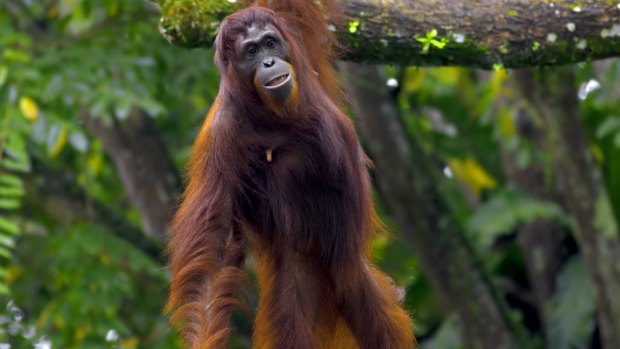
Orang-utan in the jungle in Borneo.Credit: iStock
MARMOT
Where: Mountainous areas in Europe, north-western Asia and North America.
Why we love them: A large member of the squirrel family, marmots – also called groundhogs and woodchucks – make any mountain walk fun. Most likely to be heard before being seen, their high-pitched squeals warn of impending danger. They'll stand to attention, comically tall, when on lookout for predators, an inquisitive look on their faces at all times.
Expert says: These social creatures are likely to be seen when they awake from hibernation after winter and frolic in the spring. Head out for walks on trails at a higher altitude. Belinda Fairbrother
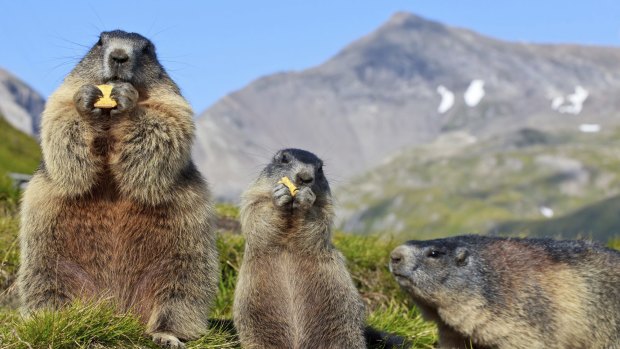
Alpine Marmot, European alps.
HUMPBACK WHALE
Where: East Coast of Australia
Why we love them: Pushed to the edge of extinction by the whaling industry last century, their protected status has thankfully seen numbers of humpbacks steadily increase, with an annual growth of around 10 per cent. Their annual migration along the east coast of Australia during winter months provides countless opportunities for observation from beaches or boats.
Expert says: Head to Sydney's beach cliffs to observe these ancient creatures of the sea gracefully breaching. Sue Badyari
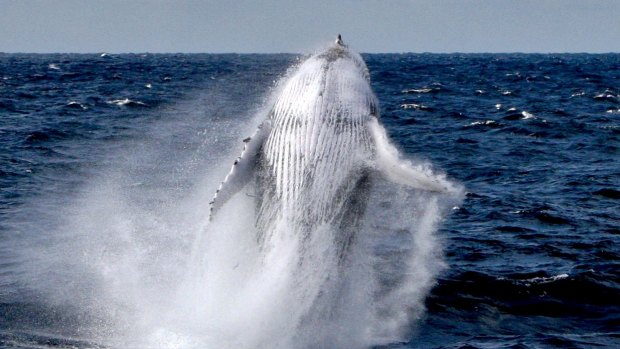
A humpback whale breaching.
CHEETAH
Where: Throughout eastern and central Africa, including Serengeti NP, Tanzania and Namibia.
Why we love them: To observe these lightning-fast cats on the hunt is a breathtaking experience, their blistering acceleration a joy to behold. You'll also often see them in trees, which they climb for a better vantage point and to rest after a kill. Although a powerful predator, this beautiful creature is also vulnerable, with its numbers dwindling to around 8000.
Expert says: Make sure you do not interfere with their hunting; if they have cubs hidden away you can really endanger them by interrupting their ability to kill. Sven Lindblad
RED DEER
Where: Throughout Europe; Exmoor, England; Scotland
Why we love them: Bambi, of course – the perfect, innocent creature of our childhoods. That such a large herd mammal can thrive in such a human-dominated habitat as Britain is a wonderful surprise.
Expert says: I'm probably biased because I grew up here but, to me, this is one of the more beautiful landscapes the world has to offer. The trick is to walk as much as you can, keep quiet, enjoy the beauty of the landscape and, if you're lucky, you'll see herds of these animals – the largest non-domesticated land mammal in Britain. John Roberts
WHALE SHARK
Where: Tropical and warm-temperate seas including Ningaloo Reef; WA and Donsol Bay, Philippines.
Why we love them: Appearing below divers from the depths, these incredibly huge and graceful filter fish glide past and disappear again with their mouths wide open, seemingly oblivious to human presence. The species is considered vulnerable due to its long lifespan and late maturation.
Expert says: Try to get dropped off in the path of the whale shark and watch it glide past rather than trying to chase or keep up with it. You need to keep a respectful distance and don't touch. Dermot O'Gorman
LEOPARD
Where: sub-Saharan Africa, northeast Africa, Central Asia, India, and China.
Why we love them: Pound for pound, the elusive leopard is the strongest of the big cats, hauling its catch up a tree with ease; while its grace and stealth on the ground is equally mesmerising. Poached for its beautiful skin, the leopard has vanished from half of its historic range in Africa, and is now listed as a 'vulnerable' species.
Expert says: Join a local, eco-friendly wildlife tour and ensure you are respectful of their space. Belinda Fairbrother
SHARK
Where: Oceans everywhere
Why we love them: The most maligned of sea creatures, sharks are the apex predators of the ocean and necessary for healthy marine environments. They are efficient, beautiful and lithe, and rarely attack humans in a deep-sea situation.
Expert says: Realise that they have little interest in attacking humans, so if you are diving, relax. Sven Lindblad
DOLPHIN
Where: Oceans everywhere
Why we love them: Prodigiously intelligent, entertaining, curious and seemingly all-knowing, dolphins love interacting with humans and are not fazed by respectful encounters in the wild. They are also great survivors, with pods appearing in the most unlikely places such as Hong Kong harbour, the Amazon and the Mekong River.
Expert says: Dolphins are just incredible to watch, playing or going about their business; there's something so complex going on but, to a land lubber such as myself, just a little out of reach. Although you find them everywhere, take your chances when they're offered. John Roberts
GIANT SEA TORTOISE
Where: Galapagos Islands
Why we love them: Weighing up to 400kg, these ancient, cumbersome creatures are a freak of nature, evolving to their giant size due to their island isolation. Being such slow-moving creatures, they make the perfect photo opportunity.
Expert says: Watching these dome-shaped shelled reptiles as they slowly crawled along the white sandy beaches of the Galapagos Islands was simply enthralling. Sue Badyari
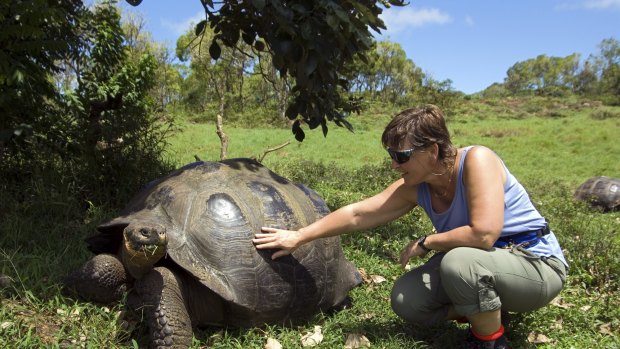
Giant Galapagos tortoise, Ecuador.
OUR EXPERTS:
Sven-Olof Lindblad is president and founder of Lindblad Expeditions, an innovative travel company offering marine-focused expeditions aboard small ships. au.expeditions.com
John Roberts is Director of Elephants and Conservation Activities at Anantara Resorts, helping with sustainability auditing and conservation activities worldwide. anantara.com and helpingelephants.org
Dermot O'Gorman is the CEO of WWF-Australia and has played a leadership role in the global conservation movement for over 20 years. worldwildlife.org
Belinda Fairbrother is the Community Conservation Manager at Taronga Conservation Society, raising awareness of issues and threats facing wild populations. taronga.org.au
Sue Badyari is the CEO of World Expeditions, an adventure travel company endorsed by the Wilderness Society in Australia. worldexpeditions.com
DOS AND DON'TS OF WILDLIFE ENCOUNTERS:
DO conduct the encounters with respect. For example if you interrupt a cheetah while hunting, it could put her offspring in danger, so good training for people conducting these experiences is important. Sven Lindblad
DON'T do anything that causes the animal to change its behaviour, such as encouraging wildlife to seek food from tourists rather than search it out naturally. John Roberts
DO become more curious and informed about the issues that impact animals in the travel experience such as riding on the back of an elephant, having a 'selfie' with a big cat or visiting aquariums with performing whales. Reflect before making travel decisions that involve animals. Sue Badyari
DON'T allow your own personal footprint to impact on wildlife. By making changes at home, such as being aware of the impacts of unsustainable palm oil, people have a chance do something to save an orang-utan, without actually seeing it in the wild. Dermot O'Gorman
DO lend your eyes to the wild – download Taronga Zoo's Wildlife Witness app (developed in conjunction with TRAFFIC, the wildlife monitoring network) and report any incidents of illegal wildlife trade that you may see. Belinda Fairbrother
See also: Top ten swimming with animals experience
Sign up for the Traveller Deals newsletter
Get exclusive travel deals delivered straight to your inbox. Sign up now.